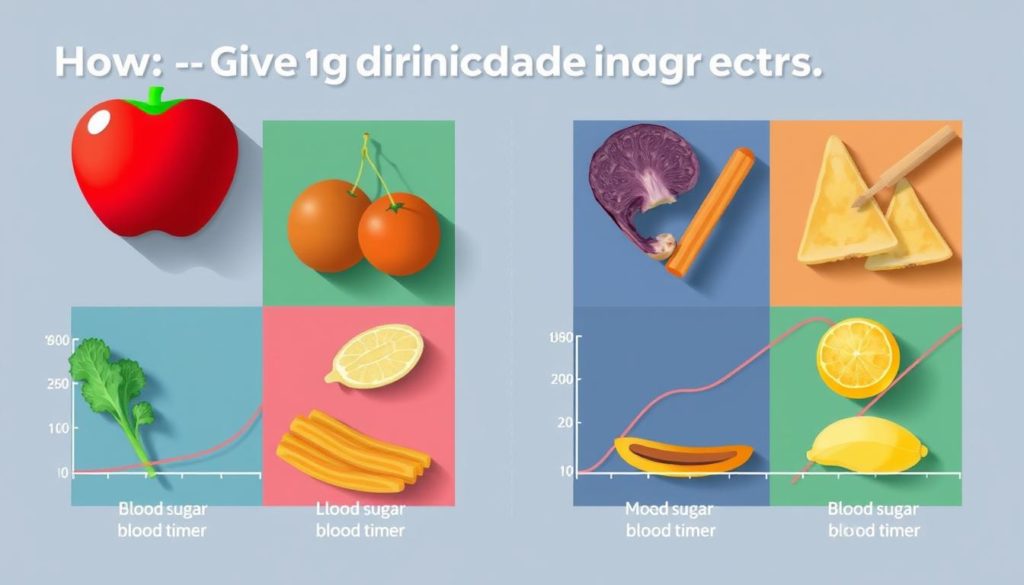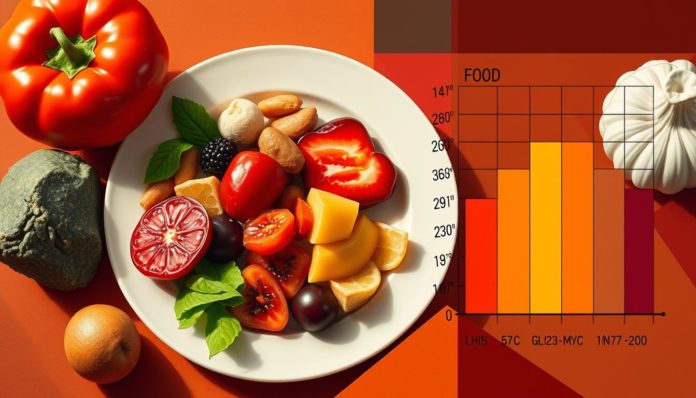Did you know high glycemic index (GI) foods can raise your blood sugar by 30% more than low GI foods? This fact is crucial for anyone planning a diabetes diet. Our guide will help you understand the glycemic index and how it affects blood sugar control for diabetics.
It’s vital to understand how the glycemic index affects your glucose. We will explain why low GI foods are important. You’ll learn how ripeness and cooking change a food’s GI. Plus, we offer tips for planning meals with the glycemic index in mind.
Focus on GI values and portion sizes for better health and sugar management. Join us on this journey to make smart food choices and control diabetes better.
Understanding the Glycemic Index
The Glycemic Index (GI) is a way to measure how fast food raises blood sugar. It ranks food from 0 to 100, with pure glucose being 100. This measure is important for foods with carbs since they affect blood sugar most.
Learning about the GI of foods helps you choose what to eat wisely. For people with diabetes, understanding how food affects blood sugar is key. Foods with a low GI are better because they don’t make your blood sugar spike suddenly. High GI foods do the opposite.
There are helpful glycemic index charts for diabetes out there. These charts show the GI values of different foods. This information helps in planning meals effectively. Let’s look at some common foods and their GI values:

| Food | Glycemic Index (GI) |
|---|---|
| Pure Glucose | 100 |
| White Bread | 75 |
| Brown Rice | 55 |
| Apple | 40 |
| Lentils | 30 |
The GI shows how food affects your blood sugar when eaten alone. When you mix foods, it changes their GI effect. Knowing this helps in managing the GI impact on diabetes better.
How Does the Glycemic Index Affect Blood Sugar Levels?
The glycemic index (GI) measures how foods impact blood sugar. Foods get a GI value based on how fast they raise blood sugar. This is vital for people with diabetes because it helps them choose what to eat wisely. To get why high GI vs low GI foods in diabetes matter, we must understand how they’re digested.

Low GI Foods
Low glycemic foods digest and absorb slowly, causing a mild rise in blood sugar. Think of nuts, legumes, non-starchy vegetables, and high-fiber cereals as examples. Eating these can keep blood sugar even, aiding in diabetes control. Choosing low glycemic foods lets people dodge big blood sugar jumps, leading to better health.
High GI Foods
However, high GI foods quickly lift blood sugar a lot. White bread, processed snacks, and sugary treats are examples. For diabetes management, knowing the impact of high GI vs low GI foods in diabetes is key. High GI foods can cause sudden spikes in blood sugar. This makes controlling glucose tough and ups the risk of health issues.
The Importance of the Glycemic Index for Managing Diabetes
Knowing about the Glycemic Index (GI) is key in controlling diabetes well. It shows how foods affect blood sugar in people with type 2 diabetes. This helps them choose what to eat wisely.
Benefits of Low GI Foods
Low GI foods are great because they release sugar slowly into the blood. This helps keep blood sugar levels steady, which is crucial for diabetes management. They also help with weight control, an important part of staying healthy with diabetes.
Eating more low GI foods helps people feel full longer. This can lead to eating less and better weight management.
Challenges with the GI Approach
However, using the GI to choose foods can be tricky. It’s not enough to just look at the GI value. The overall nutrition of foods is also important.
Some low GI foods might still be high in sugar or bad fats. This makes managing diabetes harder. It’s important to look at both the GI value and the nutrients in foods.
| Low GI Foods (Slower glucose release) | High GI Foods (Faster glucose release) |
|---|---|
| Oatmeal | White Bread |
| Legumes | Potatoes |
| Non-Starchy Vegetables | Rice |
Glycemic Index and Diabetes
Understanding the glycemic index (GI) is crucial for managing blood sugar levels. It’s especially important in diabetes diet planning. The GI shows how fast foods raise blood sugar after eating. Using GI can make a diet more diabetes-friendly.
Choosing low GI foods helps maintain stable blood sugar. It’s also key to consider the nutritional quality of foods. Things like fiber, vitamins, and minerals are essential. Fiber is great because it slows sugar absorption, aiding in managing blood sugar levels.
“Focusing on a balanced diet with low GI foods can significantly contribute to better diabetes management,” says the American Diabetes Association.
A balanced diabetes diet improves well-being. Don’t just focus on the GI. Aim for a mix of nutrient-rich foods for better nutrition. Here’s a look at low versus high GI foods and their effects on managing blood sugar levels.
| Food Type | Low GI Examples | High GI Examples |
|---|---|---|
| Fruits | Apples, Oranges | Watermelon, Pineapple |
| Grains | Oats, Quinoa | White Bread, Instant Rice |
| Vegetables | Carrots, Green Beans | Potatoes, Sweet Corn |
Identifying Low and High GI Foods
Knowing which foods have low or high GI is key in controlling diabetes. Picking the right GI foods helps keep blood sugar stable. This supports overall good health.
Examples of Low GI Foods
Low GI foods break down slowly. This leads to a slow increase in blood sugar and insulin.:
- Barley
- Quinoa
- Yogurt
- Lentils
- Sweet potatoes
Examples of High GI Foods
High GI foods break down fast. They cause a quick rise in blood sugar and insulin.:
- White rice
- Potatoes
- Honey
- White bread
- Watermelon
For effective diabetes management, mix low and high GI foods that are nutritious. Learning about GI values leads to wiser food choices. It makes managing diabetes easier.
Factors Affecting Glycemic Index of Foods
Several things affect the glycemic index (GI) of foods. These factors are important for diabetes diet planning. The ripe level of food and how it’s cooked are key in figuring out GI.
Ripeness
As fruits and veggies ripen, their GI goes up. This happens because starches change into simpler sugars. For example, a green banana’s GI is less than a ripe one’s. This info is key in diabetes diet planning. It helps keep blood sugar under control.
Cooking Methods
The way you cook food matters a lot for its GI. Foods cooked a long time, like soft pasta, have a high GI. This is different from pasta that’s a bit firmer, or “al dente”. Baking and roasting can make the GI of root veggies, like potatoes, higher than steaming or boiling.
Not just ripeness and cooking, but also fats and fibers change a food’s GI. Meals rich in fat and fiber usually have a lower GI. However, processed and refined foods often have a higher GI. Considering these things is vital for successful diabetes diet planning. It helps in picking foods that manage blood sugar better.
Combining Foods for Better GI Impact
The GI impact on diabetes can be managed by mixing different kinds of foods. Combine foods with high and low glycemic indexes to balance blood sugar. For example, eating white rice with green veggies can make a meal that’s good for diabetes.
- Include a variety of low glycemic foods like legumes, nuts, and seeds in your meals.
- Add fiber-rich vegetables to high GI meals to slow down sugar absorption.
- Incorporate lean proteins such as chicken or fish to stabilize blood sugar levels.
- Opt for whole grains over refined grains to maintain a lower GI.
By following these steps, you can effectively manage diabetes and keep a balanced diet. Trying different food combinations can make eating healthy fun and tasty.
Meal Planning with GI in Mind
Meal planning is key for those managing diabetes. It involves choosing foods with a low to medium glycemic index (GI). This helps keep blood sugar levels steady. The aim is to select foods that manage GI without sacrificing overall health.
Managing portion sizes is important in meal planning. Combining different foods can reduce the glycemic impact. For instance, eating a high-GI food with a protein lowers the meal’s total glycemic load. This practice aids in diabetes management while fulfilling other nutritional needs.
Including a variety of foods prevents nutrient shortages. Fresh vegetables, lean meats, whole grains, and legumes are great for a diabetes diet. Following these guidelines helps control blood sugar levels. Plus, it allows for a varied and enjoyable diet.
FAQ
What is the Glycemic Index (GI) and how does it help in managing diabetes?
The Glycemic Index helps manage diabetes by showing how foods affect blood sugar. Foods are rated from 0 to 100. This is based on how fast they raise glucose levels compared to pure glucose, which is 100. Low GI foods increase blood sugar slowly, making it easier to control.
Where can I find a glycemic index chart for diabetes?
You can find glycemic index charts in health books and diabetes websites. These charts show the GI values of foods. They help you choose the right foods to control your blood sugar.
What are some examples of low glycemic foods?
Foods like nuts, legumes, most non-starchy vegetables, high-fiber cereals, barley, quinoa, and yogurt are low GI. They digest slowly, keeping blood sugar stable.
What are some examples of high GI foods?
High GI foods are white bread, snacks, sugary sweets, white rice, potatoes, and honey. They quickly raise blood sugar, which complicates managing diabetes.
How do factors like ripeness and cooking methods affect the GI of foods?
Ripeness and how you cook food can change its GI value. Ripe fruits often have a higher GI. Al dente pasta has a lower GI than pasta that’s cooked longer. Adding fat or fiber lowers the GI. Processing foods tends to raise it.
What are the benefits of low GI foods for managing diabetes?
Low GI foods help keep blood sugar even, aid in weight loss, and improve overall health. They’re especially good for long-term blood sugar control in type 2 diabetes.
What are the challenges with focusing solely on GI for diabetes management?
Relying only on GI might lead to a diet high in fat and calories. It’s important to also consider the food’s fiber, vitamins, and minerals for overall health.
How can I combine foods for a better GI impact?
Eat high GI foods with low GI foods to lessen sugar spikes. Mixing white rice with veggies can lower a meal’s glycemic effect. Diverse, nutritious foods support a balanced diet.
What tips do you have for diabetes diet planning with the glycemic index in mind?
Plan your meals by choosing low to medium GI foods, watch portion sizes, and mix foods smartly to lower glycemic impact. Balance this by considering the nutritional value of your meals for steady blood sugar and good health.


